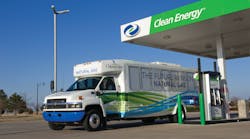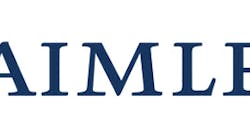Over the next five years, the natural gas heavy duty commercial vehicle market is set to experience rapid growth in North America. As diesel fuel prices remain above the $3.50 per gallon range due to tight supplies, increasing global demand and political unrest, considerable interest has grown surrounding the potential for the use of natural gas as a vehicle fuel source.
The development of natural gas engines for commercial vehicles has been occurring in small progressive steps over the past two decades and has finally reached a level of quality whereby they are comparatively reliable options. Given the low cost of natural gas in America, it offers a very high competitive price advantage over diesel fuel.
Frost & Sullivan’s recently released study titled Strategic Analysis of the North American Class 6-8 Natural Gas Truck Market reveals that by 2017, approximately 8 percent of new North American Class 6 through 8 commercial vehicles will be natural gas powered, approaching annual sales of approximately 35,000 units.
Initial Applications
The market for natural gas trucks was initially targeted to applications at port facilities, as well as select refuse fleets.
Part of the attraction for refuse fleets moving to natural gas is the prospect of fueling from landfill gas stations built on landfills that they deliver to. This not only ensured a significant fuel price savings, but also the ability to refuel on-site as part of the daily duty cycle.
Frost & Sullivan projects that natural gas refuse trucks could approach a 50 percent share of new refuse vehicle sales by 2017.
Many of the port facility vehicle purchases were made possible through government subsidies and grants which helped OEMs and engine makers run trials on this new technology. As a result of the support provided by these two industries, the technology has now been proven robust enough to be adapted and put into service on regional over-the-road delivery trucks.
These vehicles are the segment that will derive the greatest growth over the coming years.
New Engine Options
With the plethora of new engine options that will be released in the coming years, all major North American OEMs are likely to offer their own in-house engine platforms.
Cummins Westport and Westport HD will continue to see strong third-party engine supply demand.
Paccar has taken the early market lead in natural gas trucks, offering numerous Peterbilt and Kenworth trucks with the Cummins Westport ISL-G 8.9L engine. As well, Paccar stands alone as the only OEM to integrate the Westport HD 15L engine into its truck line-up.
Frost & Sullivan believes that this early mover advantage, along with the variety of vehicle platforms offered, will see Paccar continue as the market leader throughout the forecast period.
Daimler Trucks North America has also been successful in integrating the Cummins Westport ISL-G into its Freightliner product line and is expanding the range of options.
Cummins Westport is in the trials phase of the ISX-G 11.9L engine which is likely to garner large sales, and Freightliner will leverage the engine heavily to increase sales in this market.
Navistar recently announced availability of Cummins Westport ISL-G engines in its vehicle platforms, such as WorkStar and TranStar. Navistar is also expected to introduce natural gas-powered versions of key models, such as ProStar and WorkStar, based on MaxxForce 13L engine platform.
Mack Trucks have been available with the Cummins Westport ISL-G for a few years, mainly for refuse and other select vocational applications.
Recently, Volvo Trucks began offering VN series day cabs with the ISL-G engine.
Both Volvo and Mack are likely to rapidly integrate the Cummins Westport ISX-G.
It should also be noted that Volvo has developed a dual-fuel compression ignition engine option which uses a diesel and natural gas mixture of approximately 30 percent and 70 percent respectively. This engine will be offered in limited numbers this year and next before coming to broader market offerings thereafter.
These concerted efforts are expected to drive Volvo and Mack to third place in natural gas truck sales in 2017.
Fueling Infrastructure
Clean Energy Fuels is rapidly emerging as the market leader in fueling station infrastructure. It recently formed a partnership with Pilot/Flying J for fueling station expansion targeted at the long-haul sector.
Moreover, Clean Energy has launched a co-financing program with Navistar to help fleets purchase natural gas vehicles, and this is expected to benefit both companies.
Ultimately, the success of natural gas-powered vehicles will depend on the rate of the expansion of the fuelling network upon which these vehicles depend. At present, the majority of fuelling stations are “return-to-depot” models which are not open to the public.
However, Clean Energy has begun a rapid station deployment expansion exercise which will see 150 new public fuelling stations introduced over the next two to three years. This plan alone will serve as a considerable support for regional haulers throughout much of Texas, California, Nevada, Utah and other neighboring states.
One Less Obstacle
As the new engine options continue to roll out, the interest in natural gas trucks will grow in lockstep with the supporting infrastructure. Frost & Sullivan predicts that the fueling infrastructure concerns that have held the industry back will no longer be an issue throughout much of the country in 2017.
Over the coming years, the heavy duty natural gas truck market is set to see extremely rapid growth which will help many haulers reduce their total overall costs of operation, thus helping them drive towards a more stable and successful future.
This implies that fleet managers of both private and for-hire fleets must now start preparing for effectively and efficiently servicing and maintaining these green trucks that will run on a green fuel that is in abundance in U.S. and can help reducing the carbon footprint and fuel cost associated with them.
These trucks will feature new technologies and systems.
Reducing the lifecycle cost and maximizing their vehicle uptime is now officially the duty of the fleet maintenance managers.





